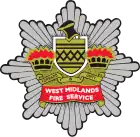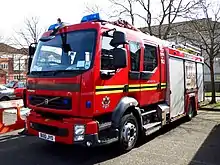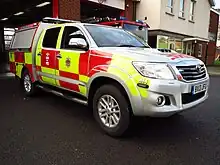 | |
| Operational area | |
|---|---|
| Country | England |
| County | West Midlands |
| Agency overview | |
| Established | 1974 |
| Employees | 1,909 |
| Facilities and equipment | |
| Stations | 38 |
| Website | |
| www | |
West Midlands Fire Service (WMFS) is the fire and rescue service for the metropolitan county of West Midlands, England. The service is the second largest in England, after London Fire Brigade. The service has 38 fire stations,[1] with a blended fleet of vehicles and specialist resources.
The service is led by Chief Fire Officer Wayne Brown,[2] who is overseen by the West Midlands Fire Authority.[3] The Fire Authority is made up of 15 councillors who represent the seven councils within the West Midlands area.
The service's headquarters is located in Nechells in Birmingham, which is also the home to Staffordshire and West Midlands Fire Control.[4] The control room, based at WMFS headquarters is the main incident management and mobilising centre for both WMFS and Staffordshire Fire and Rescue Service.[5]
History
The service was created in 1974, when the West Midlands county came into being. Prior to its creation, each of the county boroughs in the West Midlands area (Birmingham, Coventry, Dudley, Solihull, Walsall, Warley, West Bromwich and Wolverhampton) had their own fire brigade, the largest of which was the City of Birmingham Fire Brigade. WMFS was created by a merger of these county borough fire brigades, plus fire stations rom the fire brigades of Warwickshire, Worcestershire and Staffordshire.
Performance
Every fire and rescue service in England and Wales is subjected to a periodic statutory inspection by His Majesty's Inspectorate of Constabulary and Fire & Rescue Services (HMICFRS). The inspection investigates how well the service performs in each of three areas. On a scale of outstanding, good, requires improvement and inadequate, West Midlands Fire and Rescue Service has been rated rated as follows:
| Area | Rating 2018/2019[6] | Rating 2020/2021[7] | Description |
|---|---|---|---|
| Effectiveness | Good | Outstanding | How effective is the fire and rescue service at keeping people safe and secure from fire and other risks? |
| Efficiency | Good | Good | How efficient is the fire and rescue service at keeping people safe and secure from fire and other risks? |
| People | Good | Good | How well does the fire and rescue service look after its people? |
Workstreams
The service divides its main functions into three areas: response, prevention and protection.[8]
Response covers responding to emergencies, risk-based attendance standards, dynamic mobilising and Fire Control. Prevention covers their up-stream firefighting work that includes safe and well visits, community engagement, vulnerable persons officers and other individual and home-based fire prevention work. Protection covers their work around commercial and business fire safety, licensing and safety around buildings such as high-rise and apartment blocks.
Chief fire officers
The following people have held the office of chief fire officer:
- 1974–1975: George Merrell[9] (Chief Officer of Birmingham Fire and Ambulance Service from 1969)
- 1975–1981: Tom Lister
- 1981–1990: Brian Fuller
- 1990–1998: Graham Meldum[10]
- 1998–2003: Kenneth Knight[10]
- 2003–2008: Frank Sheehan[11][12]
- 2009–2013: Vijith Randeniya[13]
- 2014–2023: Phil Loach
- 2023–present: Wayne Brown[2]
Fire stations, appliances and rank structure
Frontline Appliances
The service currently uses the following frontline appliances
.jpg.webp)


West Midlands Fire Service operates 38 fire stations and employs 1,200 firefighters.[1] It has no on-call retained firefighters. All fire stations within the service are full-time, and work on two types of shift:[14]
- CORE – 10-hour day-shift, or 14-hour shift-night shift covered by four watches, comprising Red, White, Blue and Green
- LATE – 12-hour shift running from 10 am to 10 pm covered by two watches of Orange and Purple
Tettenhall is the only solely late crewed station.[14]
Following the closure of the Birmingham Central fire station, Birmingham city centre is now covered by three fire stations: Aston located and covering the northern side, Highgate located and covering the southern, central and eastern sides, and Ladywood covering the western side.
WMFS currently operates a fleet of pump rescue ladders, technical rescue pumps, brigade response vehicles, aerial ladder platforms which are also referred to as Hydraulic platforms. WMFS also operate business support vehicles in addition to various specialist appliances and transport vehicles.
Rank Structure
West Midlands Fire Service uses the following rank structure:
• Chief Fire Officer
• Deputy Chief Fire Officer
• Assistant Chief Fire Officer
• Area Manager
• Group Manager
• Station Manager
• Watch Manager
• Crew Manager
• Firefighter
• Trainee Firefighter
- Following the ‘ranks to roles’ adoption in 2004. WMFS Managers’ are known as such during day to day operations, however during operational incidents the word manager is replaced with ‘Commander’. E.g Watch Commander.
Specialist units
Technical Rescue Unit
Operating out of three locations, a primary base at Bickenhill fire station and two other bases at Wednesbury and Sutton Coldfield fire stations, the WMFS Technical Rescue Unit has provides specialist rescue services such as rope and water rescue, dangerous buildings, and vehicle incidents involving trains and heavy goods vehicles.[15]
International search and sescue
The United Kingdom International Search and Rescue Team (UK-ISAR) is on call 24 hours a day, 365 days a year to respond to humanitarian accidents or disasters anywhere in the world.[16] WMFS personnel are on call as UK-ISAR volunteers to respond to international incidents.
Twelve members of the West Midlands team were deployed as part of the UKISAR (United Kingdom International Search And Rescue) mission to Haiti in the wake of the earthquake there on 12 January 2010.[17] The team members were joined by two further members who had been in Sweden as part of a training exercise at the time of the earthquake. The team members were involved in the rescue of several people, including two-year-old Mia, who had been trapped for over four days.[18]
Fire Investigation and Prevention Section
The Fire Investigation and Prevention Section (FIPS) investigates the cause of fire in a variety of different types of incidents including large fires, fires where the cause cannot be immediately determined, and fires where people may have been injured or died. FIPS works closely with the Police, other services, and organisations such as insurance companies when investigating fires.[19]
The officers also work on special projects including arson reduction policies and strategies, human behaviour in fire, the main causes of fire, and the compilation of any information to identify trends in fire causes. This information is vital when undertaking targeted initiatives and campaigns relating to the education of fire safety awareness.
Notable incidents
- 2013 Smethwick fire – 35-pump fire, 50,000 tonnes of plastic and Jayplas plastics and paper recycling plant on fire, sparked by a Chinese lantern.[20]
Recruitment controversy
In 2019, the WMFS was accused of using discriminatory practices in recruitment of new firefighters. Once candidates had passed a reactions test, they moved on to a numerical, verbal and mechanical reasoning exam. Media reports stated that black, Asian and minority ethnic and female candidates were deemed to have passed the test with a score of 60% or higher, but white male candidates were required to score at least 70%.[21] Member of Parliament David Davies condemned the policy, stating "It's totally bonkers. They should just be picking the best man or woman for the job. They shouldn't be lowering the target for anyone just to meet a target." The service has target of 60% of new recruits to be female by 2021 and 35% to be ethnic minorities. In repose to criticism, the WMFS did not comment on whether it had different pass marks for different groups, but said that it was committed to diversity among the firefighting force.[22][21]
See also
References
- 1 2 "About us". West Midlands Fire Service. Retrieved 13 June 2021.
- 1 2 "Appointment of Chief Fire Officer". West Midlands Fire Service. 19 April 2023.
- ↑ "Governance and Leadership". West Midlands Fire Service. Retrieved 12 June 2019.
- ↑ "Fire Control". West Midlands Fire Service. Retrieved 12 June 2019.
- ↑ "Staffordshire Fire and Rescue Service". staffordshirefire.gov.uk. Retrieved 12 June 2019.
- ↑ "West Midlands 2018/19". Her Majesty's Inspectorate of Constabulary and Fire & Rescue Services (HMICFRS). 20 June 2019. Retrieved 22 November 2021.
- ↑ "West Midlands 2020/21". His Majesty's Inspectorate of Constabulary and Fire & Rescue Services (HMICFRS). 20 January 2023. Retrieved 19 June 2023.
- ↑ "Our Plan". West Midlands Fire Service. Retrieved 12 June 2019.
- ↑ "Hail to the Chief". Birmingham Post. 7 August 2002. p. 22.
- 1 2 "Woman saved in fire drama; Kenneth new fire chief for region". Birmingham Evening Mail. 31 January 1998. p. 4.
- ↑ "Meet chief fireman Frank". Birmingham Post. 12 August 2003. p. 4.
- ↑ "'Surprise' as firefighters' chief resigns". Birmingham Mail. 19 November 2008. p. 3.
- ↑ "Hard work is key, says new WM fire chief". Birmingham Mail. 20 March 2009. p. 11.
- 1 2 "Our fire stations". West Midlands Fire Service. Retrieved 13 June 2021.
- ↑ Panter, Matthew (13 May 2022). "Sutton Coldfield Fire station unveiled as Technical Rescue Unit". Express and Star. Birmingham / Sutton Coldfield. Retrieved 19 June 2023.
- ↑ "International Search and Rescue". West Midlands Fire Service. Retrieved 12 June 2019.
- ↑ "International Search and Rescue".
- ↑ "British rescue teams pull three survivors including Mia, two, from the rubble".
- ↑ "ORDER NO. 15/19 West Midlands Fire Service Fire Investigation". What Do They Know. West Midlands Fire Service. 27 February 2017. Retrieved 19 June 2023.
- ↑ "Bosses speak out over "tragic accident" as Chinese lantern sparks region's biggest fire". Express & Star. Retrieved 1 July 2013.
- 1 2 "Fire brigade accused of discrimination after drive to recruit more women and ethnic minorities". uk.news.yahoo.com.
- ↑ Correspondent, Michael Knowles, Home Affairs (28 January 2019). "Fire chiefs make it harder to get a job if you're a white man". Express.co.uk.
{{cite web}}: CS1 maint: multiple names: authors list (link)